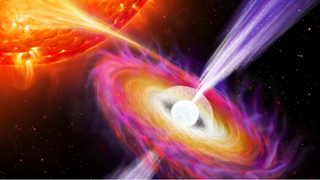In the celestial ballet of death, a new chapter unfolds. Astronomers have unveiled a captivating connection between the fiery jets launched by “vampire” neutron stars and the thermonuclear explosions that fuel their existence.
This discovery not only sheds light on the enigmatic processes within these ravenous stellar corpses, but also holds the key to unlocking the mysteries of jet formation around supermassive black holes, the galactic giants residing at the heart of galaxies.
Cosmic Vampires: A Feast of Fire and Fury
Imagine a neutron star, the ultra-dense remnant of a colossal star that perished in a supernova explosion. Now, picture this neutron star reawakening in a cosmic dance macabre. Locked in a close embrace with a companion star, its immense gravity siphons off stellar material, transforming it into a celestial vampire. As this stolen bounty spirals inwards, it ignites a series of thermonuclear explosions on the neutron star’s surface. These violent outbursts release tremendous energy, a portion of which gets channeled towards the poles, erupting as powerful astrophysical jets traveling at near-light speeds.
A Celestial Whodunit: Unveiling the Enigma of Jet Formation
For decades, astronomers have grappled with a central question: what ignites these awe-inspiring jets? Two primary theories dominated the discourse:
- The Spinning Infall: The swirling motion of the stolen material as it spirals inwards could be the driving force behind the jets.
- The Stellar Spin: The rotation of the neutron star itself might be the key ingredient propelling the jets.
New research offers a compelling lead in unraveling this cosmic whodunit. Scientists have devised a method to measure the speed of these jets and correlate it with the properties of both the feasting neutron star and its unfortunate companion.

Thermonuclear Bursts and Jet Speed: A Cosmic Connection
The key lies in the thermonuclear explosions on the neutron star’s surface. By meticulously studying two such systems – the X-ray binaries 4U 1728-34 and 4U 1636-536 – researchers observed a fascinating link. These systems, notorious for their periodic thermonuclear bursts, provided a unique opportunity. Using a combination of X-ray and radio telescopes, the team discovered a remarkable correlation: the bursts coincided with distinct changes in the jets’ radio emissions. Essentially, the explosions acted like an injection of fuel, momentarily boosting the jets’ radio brightness.
This intriguing observation suggests a strong coupling between thermonuclear bursts and the evolution of jets. It’s as if the explosions act as a cosmic trigger, influencing the behavior of the jets in a profound way.
A Cosmic Speed Camera Unveils the Missing Piece
The missing piece of the puzzle, according to the research team, is the speed of the jets. Measuring this speed provides a crucial window into the jet launching mechanism.
“The speed is incredibly important to understanding how the jets are launched,” explains lead author Thomas Russell. “This new discovery opens a very accessible window to answer that question.”
Neutron Stars: A Rosetta Stone for Black Hole Jets
This research marks a significant leap forward for several reasons:
- First Jet Speed Measurement: For the first time, scientists have directly measured the speed of a jet emanating from a feeding neutron star.
- A Probe into Black Hole Jets: While jet speeds for black holes have been measured, neutron stars offer a distinct advantage. Their properties like spin, mass, and magnetic field can be more precisely determined, making them a valuable tool for understanding jet formation around black holes.
- Identifying the Dominant Mechanism: By studying a larger sample of bursting neutron stars, scientists can compare jet speeds with various neutron star properties. This comparison could reveal whether the spin of the infalling material or the neutron star itself plays the leading role in launching jets.
A Universe Illuminated: Beyond the Dance of Death
The research team is currently expanding their investigation to encompass more bursting neutron stars. Their goal is to build a robust data set that can definitively identify the key ingredients for jet production.
Understanding the jet launching mechanism in these “vampire” neutron stars has far-reaching implications. It could provide the key to unlocking the secrets of jet formation around supermassive black holes, celestial powerhouses residing at the heart of galaxies. These jets are believed to play a crucial role in shaping the evolution of galaxies and the universe itself.
This research is a testament to the power of scientific collaboration and innovation. By studying these stellar vampires and their blazing jets, we are inching closer to understanding the dynamic and energetic processes that govern our universe. The dance of death, it seems, holds the key to illuminating the very nature of existence.



















